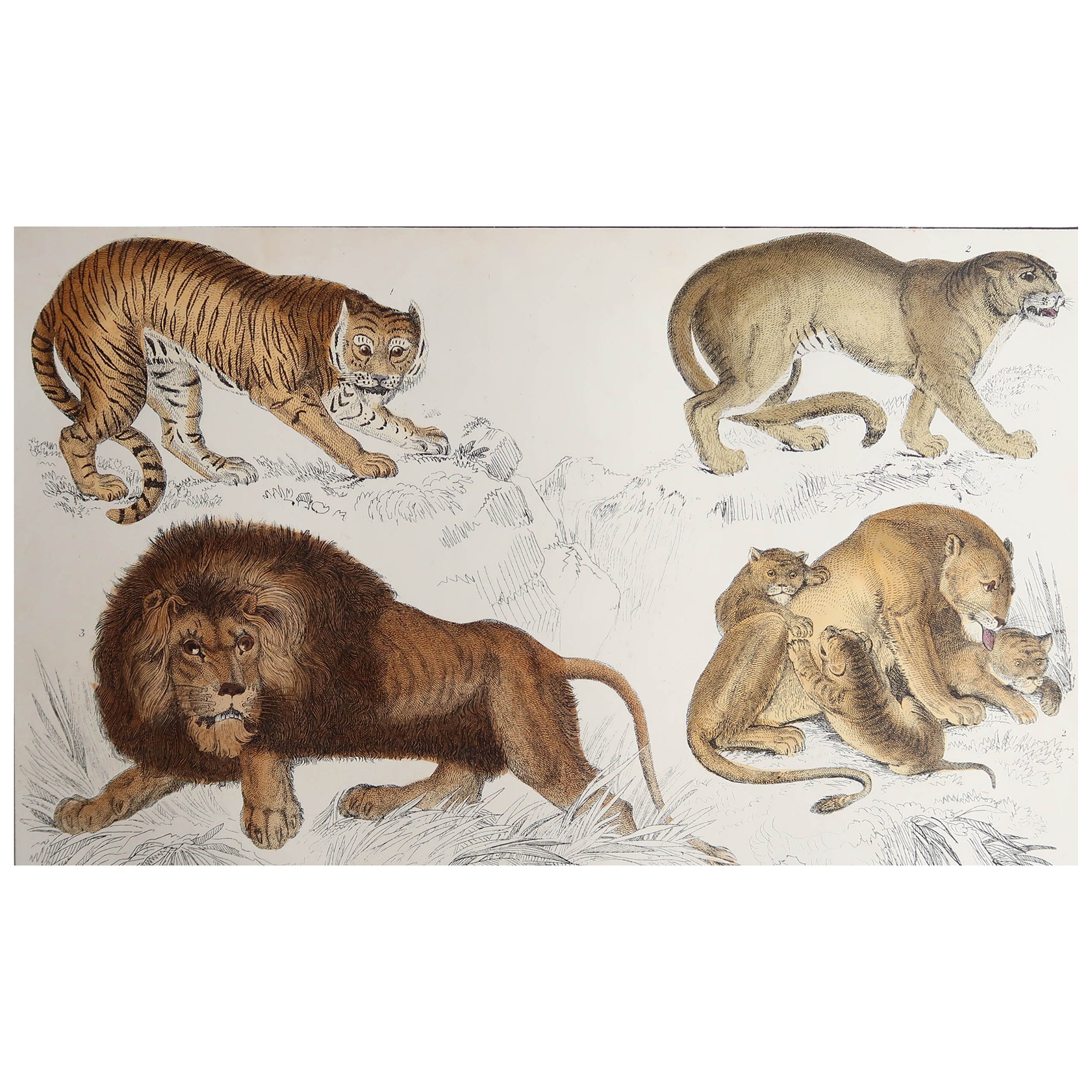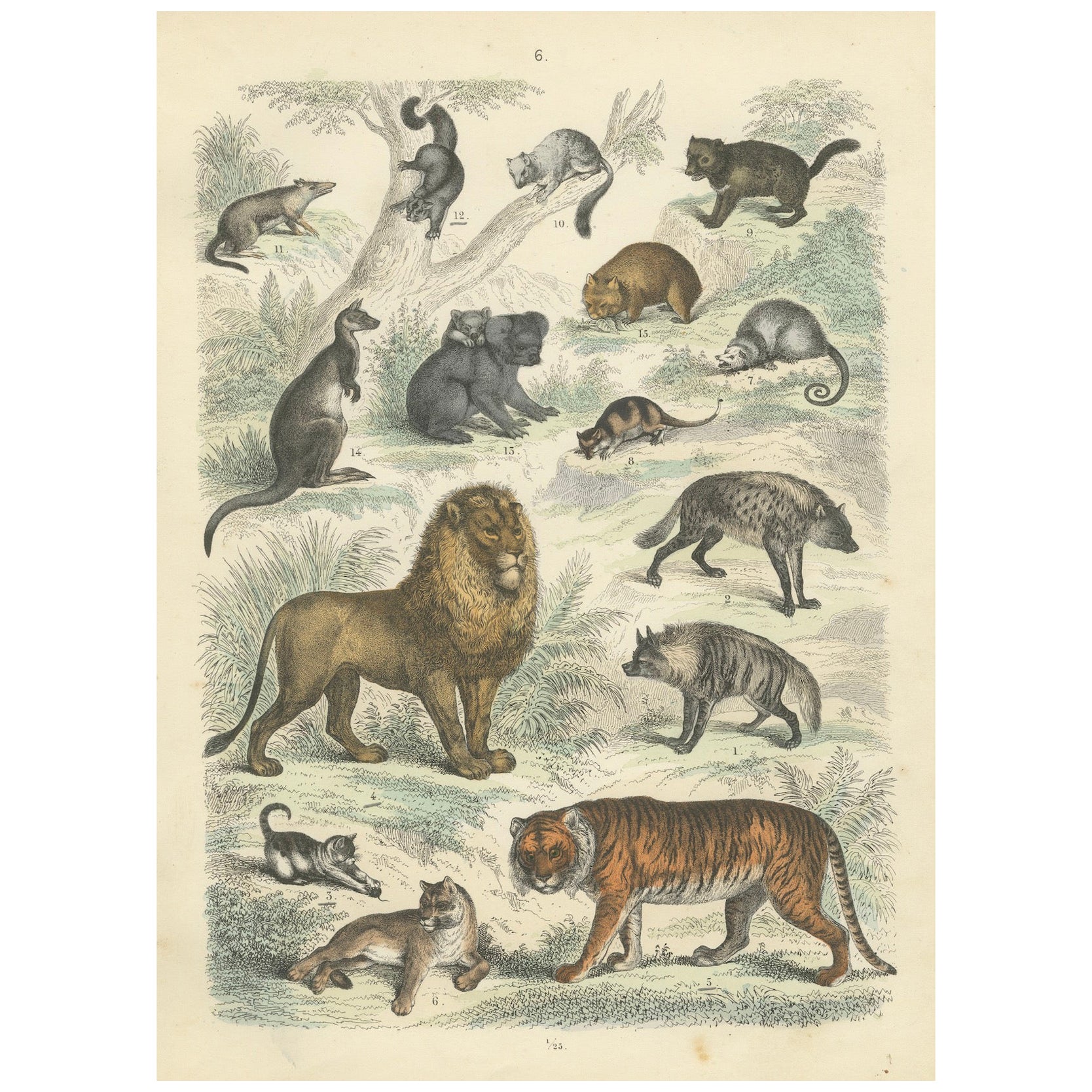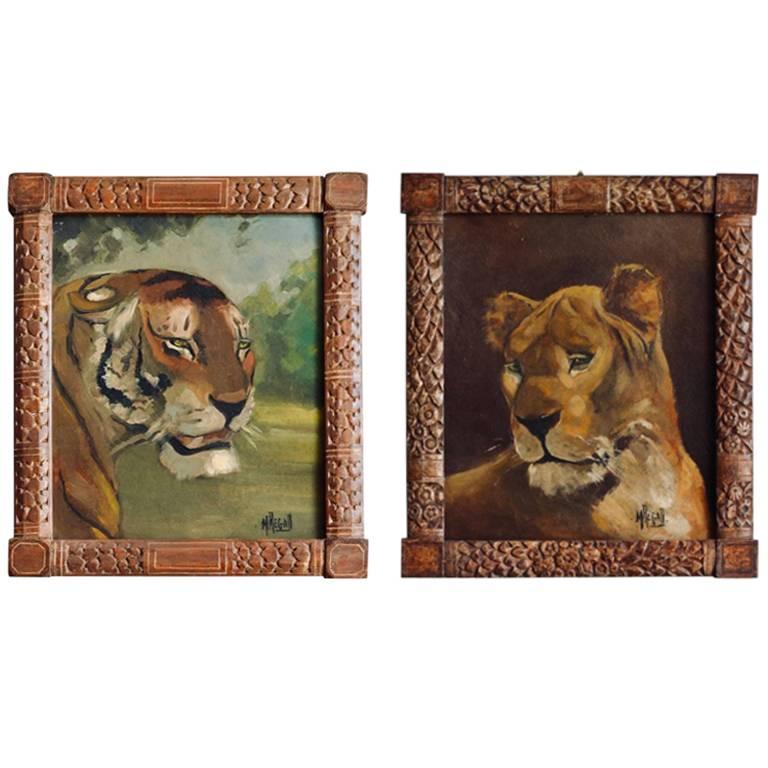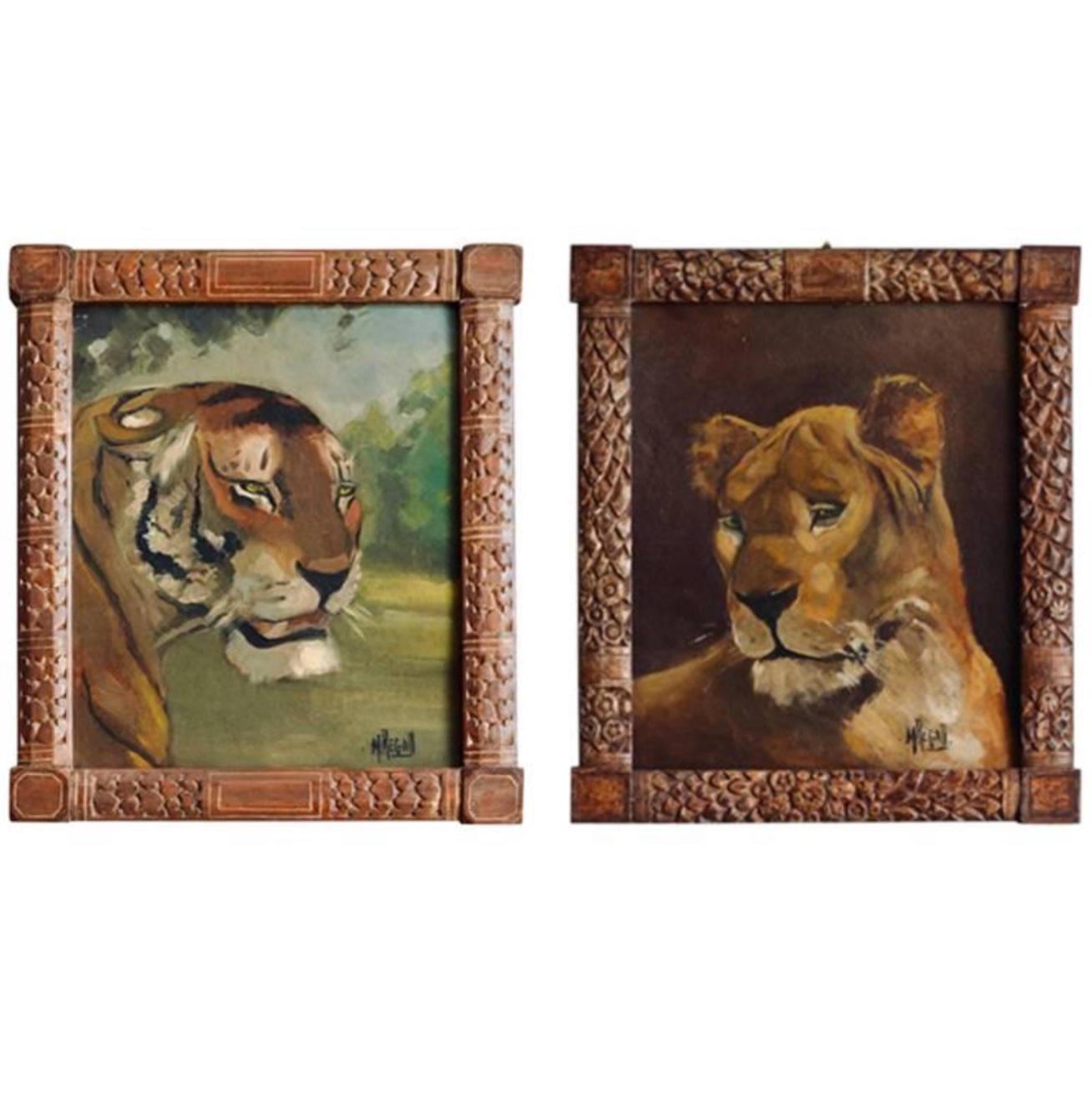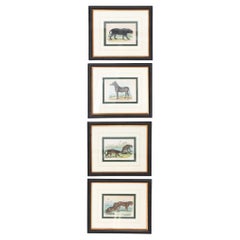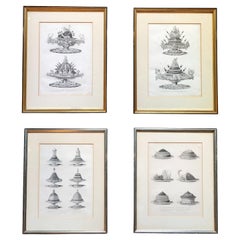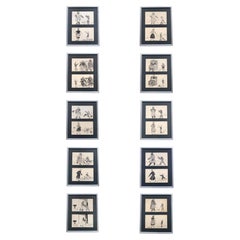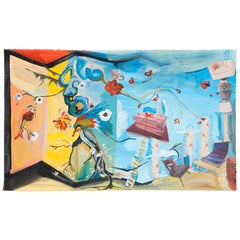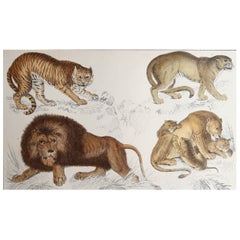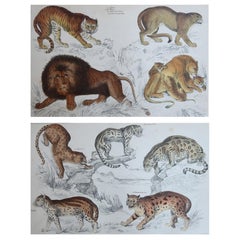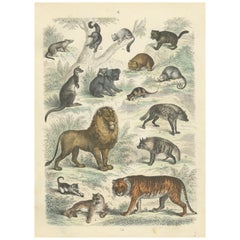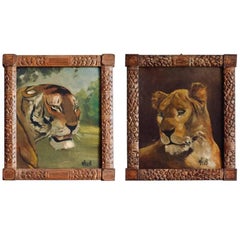Items Similar to Karl Joseph Brodtmann Lithographs of Big Cats
Want more images or videos?
Request additional images or videos from the seller
1 of 10
Karl Joseph Brodtmann Lithographs of Big Cats
$1,800per set
£1,360.58per set
€1,563.54per set
CA$2,506.49per set
A$2,788.37per set
CHF 1,461.70per set
MX$34,073.15per set
NOK 18,612.88per set
SEK 17,521.45per set
DKK 11,671.27per set
Shipping
Retrieving quote...The 1stDibs Promise:
Authenticity Guarantee,
Money-Back Guarantee,
24-Hour Cancellation
About the Item
Two lithographs depicting a lion and a tiger, by the Swiss engraver Karl Joseph Brodtmann (1787-1862). Originally published in the early 19th Century, these lithographs were printed in the 20th Century and are presented here in exquisite gilt wood frames.
Dimensions:
Frame: 19.25 in. x 22.5 in. x 1 in.
Sight: 13" x 16.5 in.
Condition notes:
In good condition with minor scuffs and nicks to frames, all consistent with their age and use.
- Dimensions:Height: 19.25 in (48.9 cm)Width: 22.5 in (57.15 cm)Depth: 1 in (2.54 cm)
- Sold As:Set of 2
- Materials and Techniques:
- Place of Origin:
- Period:
- Date of Manufacture:20th Century
- Condition:Additions or alterations made to the original: Giltwood frames were a later addition to the prints. Wear consistent with age and use. In good condition with minor scuffs and nicks to frames, all consistent with their age and use.
- Seller Location:New York, NY
- Reference Number:1stDibs: LU1569245235252
About the Seller
4.9
Vetted Professional Seller
Every seller passes strict standards for authenticity and reliability
1stDibs seller since 2015
205 sales on 1stDibs
Typical response time: 2 hours
- ShippingRetrieving quote...Shipping from: Pound Ridge, NY
- Return Policy
Authenticity Guarantee
In the unlikely event there’s an issue with an item’s authenticity, contact us within 1 year for a full refund. DetailsMoney-Back Guarantee
If your item is not as described, is damaged in transit, or does not arrive, contact us within 7 days for a full refund. Details24-Hour Cancellation
You have a 24-hour grace period in which to reconsider your purchase, with no questions asked.Vetted Professional Sellers
Our world-class sellers must adhere to strict standards for service and quality, maintaining the integrity of our listings.Price-Match Guarantee
If you find that a seller listed the same item for a lower price elsewhere, we’ll match it.Trusted Global Delivery
Our best-in-class carrier network provides specialized shipping options worldwide, including custom delivery.More From This Seller
View AllZoological Etchings by William Panormo - A Set of 4
Located in New York, NY
Four colored etchings depicting a menagerie of animals: a zebra, a pair of leopards, a panther, and a pair of tigers rendered with bold colors and delicate line-work. The original et...
Category
20th Century English Prints
Materials
Glass, Wood, Giltwood, Paper
Antique Engravings From La Cuisine Classique, a Set of 4
Located in New York, NY
A set of 4 black-and-white engravings from the book La Cuisine Classique by chefs Émile Bernard and Urbain Dubois. Published in the 19th Century, the illust...
Category
Antique Late 19th Century Prints
Materials
Glass, Wood, Paper
Framed Series of Odd & Disturbing Pen & Ink Drawings - A Set of 10
Located in New York, NY
This series of framed vintage pen and ink drawings on paper depicts a curious relationship between two groups of parent-and-child figures who seem to mirror each other. Each frame pr...
Category
20th Century Drawings
Materials
Plexiglass, Giltwood, Paper
George Venson Original Illustration
By George Venson
Located in New York, NY
The title of this original illustration by the artist George Venson is "Jumping Ship: An Illustration of the Way I See Things Right Now". It is a...
Category
21st Century and Contemporary American Paintings
Materials
Paper, Gouache
Robsjohn-Gibbings Style Zebra Print Dining Chairs - A Set of 7
By T.H. Robsjohn-Gibbings
Located in New York, NY
Made in the 20th Century, this set consists of seven chairs. The design of the chairs brings to mind the sleek, elegant lines of Robsjohn-Gibbings's classicism-infused modern furnitu...
Category
20th Century Modern Dining Room Chairs
Materials
Upholstery, Ultrasuede, Wood
René Zimmermann Landscape Painting
By Rene Zimmermann
Located in New York, NY
René Zimmermann (1904-1991) was a French painter, printmaker and illustrator. His many landscapes includes this remarkable blue-skied oil painting, "Noria de la Province de Murcia, E...
Category
20th Century French Modern Paintings
Materials
Canvas
You May Also Like
Original Antique Print of Lions and Tigers, 1847 'Unframed'
Located in St Annes, Lancashire
Great image of lions.
Unframed. It gives you the option of perhaps making a set up using your own choice of frames.
Lithograph after Cpt. Brown with original hand color.
Pub...
Category
Antique 1840s English Folk Art Prints
Materials
Paper
Original Antique Animal Prints, Lions and Tigers, 1847
Located in St Annes, Lancashire
Great images of Lions and tigers
Unframed.
Lithographs after Cpt. Brown with original hand color.
Published, 1847.
The measurement is for 1 print
Free shipping
Category
Antique 1840s English Folk Art Prints
Materials
Paper
Big Cats & Marsupials Print: Lion, Tiger, Kangaroo – Antique 1867
Located in Langweer, NL
Big Cats & Marsupials Print: Lion, Tiger, Kangaroo – Antique 1867
This striking antique print depicts a variety of big cats, marsupials, and other mammals in detailed hand-coloured ...
Category
Antique 1860s German Prints
Materials
Paper
Pair of Tiger and Lion Art Deco Framed Paintings
Located in Los Angeles, CA
Pair of tiger and lion Art Deco framed paintings. Oil on panel. Beautiful carved wood frames.
Category
Vintage 1930s French Art Deco Paintings
Materials
Hardwood, Paint
$2,800 / set
Pair of Tiger and Lion Art Deco Framed Paintings
Located in Los Angeles, CA
Pair of tiger and lion Art Deco framed paintings. Oil on panel. Beautiful carved wood frames.
Category
Vintage 1930s French Art Deco Paintings
Materials
Paint, Hardwood
$2,800 / set
Original Antique Print of Cats, 1847 'Unframed'
Located in St Annes, Lancashire
Great image of cats.
Unframed. It gives you the option of perhaps making a set up using your own choice of frames.
Lithograph after Cpt. brown with original hand color.
Published,...
Category
Antique 1840s English Folk Art Prints
Materials
Paper
More Ways To Browse
Chinese Lacquer Fan
Chinese Rank Badges
Chinese Scholars Cabinet
Chinoiserie Secretary
Clara Saint
Cloisonne Brass Box
Cloud Bed Frame
Copper Enamel 1970 Artist
Corner Drinks Cabinet
Court Jester
Crank Handle
Curtis Jere Enamel
Cypress Doors
Danish Drinks Trolley
Danish King Bed
Danish Rosewood Bedside
Daum Crystal Animals
Demi Lune Commode
